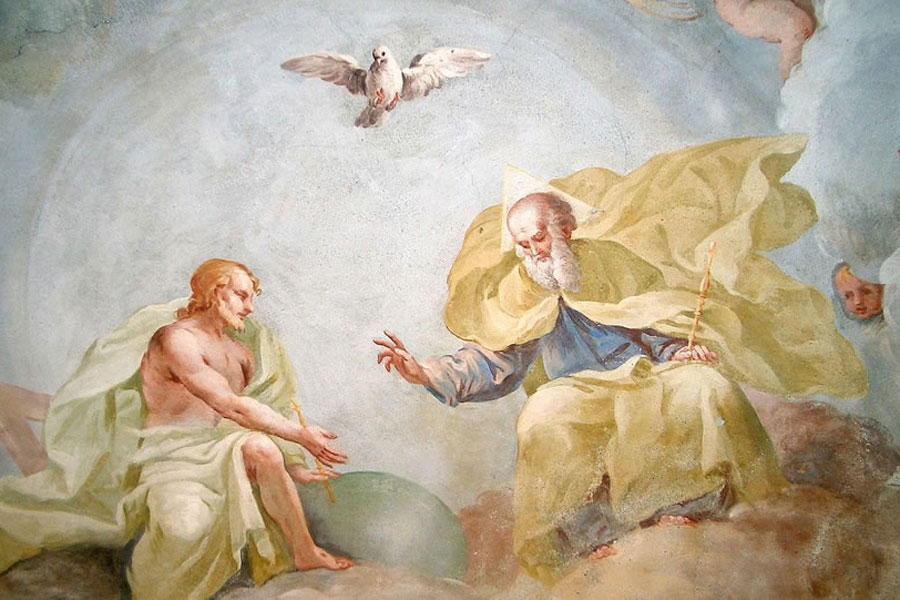
The Doctrine of the Trinity Part 1
by Fr. Tony Okolo C.S.Sp., V.F. | 06/15/2025 | Weekly ReflectionBeloved Parishioners,
I will begin today’s reflection thus: In the name of the Father and of the Son, and of the Holy Spirit, Amen.
Significantly, my opening lines are at once, like you must have figured out, a prayer, a proclamation of faith, a doctrine, an identity, and a character for starting every liturgical activity in the Church.
We are called Christians expressly because we believe in Christ Jesus who was sent by the Father and anointed by the Spirit and thus, we profess a triune or triadic God — the Doctrine of the Holy Trinity. The Catechism of the Catholic Church (CCC) presents the doctrine of the Holy Trinity as the central mystery of the Christian faith and life, revealed by God as one God in three distinct Persons: Father, Son, and Holy Spirit (CCC, 261).
It teaches that: God is one in essence (substance or nature) but exists as three distinct Persons who are coequal, coeternal, and consubstantial (CCC 253, 266), the eternal relations of origin within the Godhead is such that the Father is unbegotten, the Son is eternally begotten of the Father, and the Holy Spirit proceeds from the Father and the Son (CCC 262-264), the three Persons are inseparable in what they are and what they do, especially in the missions of the Son’s Incarnation and the gift of the Holy Spirit (CCC 267). This is a deep mystery! The Catechism emphasizes that the Trinity is a mystery of faith that surpasses human understanding but is revealed by God and entrusted to the Church.
If you search the Bible, you just may not find any explicit mention of “Trinity” as a qualification for the Godhead, but this doctrine finds support in both Old and New Testament scripture since the Bible contains several passages Christians have long seen as foreshadowing a plurality within the one Godhead. Several Old Testament passages use plural language when speaking of God or depict the divine presence in multi-personal terms. For example, Genesis 1:26 records God saying, “Let us make man in our image, after our likeness.” The early Church Fathers read this plural “us” as a hint of the Trinity. Early Church Fathers like Gregory of Nyssa, Augustine, Basil of Caesarea, Tertullian, Clement of Alexandria argue that the plural verb “Let us make” deliberately reveals the Holy Trinity. They interpret Genesis 1:26 as an embryonic foreshadowing of the Trinity, where one divine Person addresses another. Other Old Testament texts also use plural or multi-person imagery. Genesis 3:22–24 has God saying, “Behold, the man has become like one of us, knowing good and evil.” Similarly, at Babel God says, “Come, let us go down and confuse their language.” Here too God’s words use “us”; the narrative clarifies that it is the LORD (YHWH) himself who performs the action (Genesis 11:8), supporting the reading that a multi-person God is speaking.
These plural usages (“us,” “one of us”) suggest that even the Old Testament view of God is not strictly monadic. A particularly Trinitarian-like verse is Isaiah 48:16: “And now the LORD God has sent me, and his Spirit.” Early exegetes took this as involving Father, Son, and Spirit. Likewise, later passages like Isaiah 63:7–10 contrast the Lord and His Spirit (v.10 shows the people vexing “His Holy Spirit”), which Patristic writers saw as evidence of a plural deity in Isaiah’s vision.
Unlike the Old Testament, the New Testament contains explicit references to Father, Son, and Holy Spirit together and fully identifies the Son and Spirit as divine. In Matthew 3:16–17 during the Baptism of Jesus, all three Persons appear: “Jesus…went up from the water, and behold, the heavens were opened…and he saw the Spirit of God descending like a dove…; and behold, a voice from heaven said, ‘This is My beloved Son, with whom I am well pleased’.” The appearance of the three Persons of the Godhead shows that each is active and distinct yet united. To be concluded next week.
BACK TO LIST